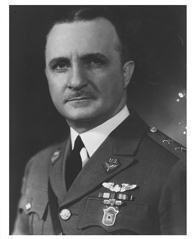Nickname(s) Tubby Name Oscar Westover | Years of service 1901 - 1938 Battles and wars World War I | |
 | ||
Born July 23, 1883Bay City, Michigan ( 1883-07-23 ) Allegiance United States of America Awards Distinguished Service Medal, World War I Victory Medal | ||
Oscar M. Westover (July 23, 1883 - September 21, 1938) was a major general and fourth chief of the United States Army Air Corps.
Contents
Biography
He was born in Bay City, Michigan and enlisted in the Army when he was 18. He began his service as a private in 1901 before being appointed to the United States Military Academy at West Point. He graduated from there in 1906, ranked 43rd in his class, and was commissioned as a second lieutenant in the 14th Infantry. Westover was promoted to first lieutenant on April 13, 1911; to captain on July 1, 1916; and brevetted to major on October 20, 1917.
Air Service and Air Corps
In 1919 Lt. Col. Westover was detailed to the Air Service to serve as Assistant Executive Officer for Director Maj. Gen. Charles Menoher, where he butted heads with Billy Mitchell over subordination to authority, and on July 1, 1920, transferred permanently to the new Air Service branch with the rank of major. Westover served as Assistant Executive and Executive in the Office of the Chief of the Air Service (OCAS), from November 1918 to November 1920. He was appointed director of aircraft production in April 1921, serving until December 1922.
Westover attended the Air Service Balloon School in 1921, and the Air Service Airship School in 1922. He continued on to heavier-than-air flight training, completing the Air Service Primary Flying School at Brooks Field and the Advanced Flying School at Kelly Field in 1923 at the age of forty. As a result of these courses, Westover was awarded aeronautical ratings as a balloon observer, airship pilot, airplane pilot, and airplane observer, at that time every rating authorized by the Air Service.
From 1924 to 1926 he was assigned as commanding officer of Langley Field, Virginia, who was also the commandant of the Air Service Tactical School (which became the Air Corps Tactical School in 1926). He then completed the ACTS course himself in 1927. On January 13, 1930 he was promoted to lieutenant colonel and on December 22, 1931 appointed assistant to the chief of the Air Corps with temporary promotion to brigadier general. In 1932 he attended the Command and General Staff College and remained there for a stint as an instructor. On December 22, 1935, he succeeded Benjamin Foulois as Chief of the Air Corps with the accompanying promotion to major general.
The Army had consolidated command of all aviation combat units based in the United States under the General Headquarters Air Force earlier in 1935. Although the Chief of Air Corps had never had operational control of these units (previously the jurisdiction of the commanders of the corps areas in which they were based), GHQ Air Force was a coordinate command of equal standing to the Air Corps, with both reporting the Chief of Staff of the Army. GHQ Air Force was commanded by Maj. Gen. Frank M. Andrews, a classmate of Westover's who had finished one place higher in class standings. This dual authority within the aviation arm caused many problems in unity of command, particularly since Andrews was outspoken in his advocacy of independence for the Air Corps from the Army. He and Westover clashed often over philosophical differences on this issue (Westover, while favoring an independent Air Force, believed that subordination to the Army had a higher priority), as had Westover with Billy Mitchell.
Death
Westover died, aged 55, in a plane crash on September 21, 1938. The Northrop A-17AS he flew, a single-engined attack aircraft used as a high-speed staff transport, had a reputation for stalling, and only a year before, Col. William McChord, had been killed in the crash of one. Westover's aircraft, AC serial 36-349, experienced a high-speed stall and crashed in a crosswind short of the runway at Lockheed Aircraft's air field in Burbank, California, now known as Bob Hope Airport. The plane crashed in the front yard of a house at 1007 Scott Road in Burbank. No one on the ground was killed, but two homes were damaged by the ensuing flames. His passenger, crew chief S/Sgt Samuel Hymes, also died.
Westover was succeeded by the Assistant Chief of Air Corps, Brig. Gen. Henry H. Arnold on September 29.
Oscar Westover is buried in Arlington National Cemetery. Westover Joint Air Reserve Base in Chicopee, Massachusetts, formerly the headquarters of the Eighth Air Force, and now the largest reserve base in the Air Force as home to the 439th Airlift Wing, is named in his honor.
